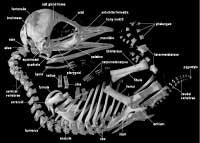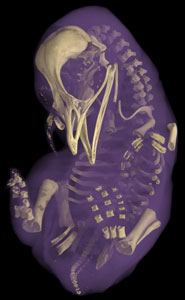 Expert annotations for this species! See below. Expert annotations for this species! See below.
Aptenodytes forsteri, the emperor penguin, is a flightless Antarctic bird with extremely distinctive morphology and behavior. Penguins in general (see also Spheniscus demersus, the jackass penguin) are highly derived avians with no clear relatives among other living birds, although most studies suggest that they are related to one among a number of seabirds. These possible sister groups include loons (Olson 1985), loons and grebes (Sibley and Ahlquist, 1990; Mayr and Clarke, 2003), and tubenoses (albatrosses and petrels; Simpson, 1946; Livezey and Zuzi, 2001; Bertelli and Giannini, 2005). This confusion is probably due to convergence among seabirds adapted to similar environments, and to the fact that penguins evolved nearly 55 million years ago and have since undergone extreme morphological and genetic modification (Fordyce and Jones, 1990). |
|
Relationships within penguins are also controversial and largely unresolved, although the six living genera almost certainly form natural groups. The aptenodytid penguins, which include the emperor penguin and the king penguin (Aptenodytes patagonicus), may be most closely related to the pygoscelid penguins (the Adelie, Gentoo, and Chinstrap). Alternatively, they may be the earliest group of living penguins to have evolved, with no close relationship to any other penguin species. This hypothesis is supported by penguin biogeography: because penguins likely originated in Antarctica, the species of penguins living there today probably evolved first.
Emperor penguins are unique in being the largest living penguins (averaging 120 cm in height), with the most southerly of all penguin ranges. They live year-round solely in Antarctica and have accordingly evolved numerous adaptations to their frigid, aquatic existence. These include specialized salt glands (which allow them to drink salt water), extremely flattened wing bones, and a unique system of water-proof feathers (Davis and Renner, 2003). They can be recognized by a distinctive flipper coloration, an orange-pink bill, chicks that hatch almost naked, and an additional anterior opening in their lower jaw bone (Bertelli and Giannini, 2005). They are also very bulky (averaging about 35 kg), with extremely long, gracile, and straight beaks, and a large bony orbit (personal observation).
Emperor penguins eat mainly krill, fish, and squid, and breed far inland during the Antarctic winter (Williams, 1995). Male emperors may therefore fast for up to 120 days during the courtship and incubation periods; these penguins produce only one egg per year. Fortunately, they may live longer than 20 years and are currently not endangered.
Additional Information on the Skeleton
 |
Click on the thumbnail to the left for a labeled image of the juvenile Aptenodytes skeleton in lateral view. |

About the Species
This specimen was captive-born at Sea World San Diego on September 10, 1996. It was one day old when it died of natural causes. It was made available to The University of Texas High-Resolution X-ray CT Facility for scanning by Dr. Nina Triche of the UT Department of Geological Sciences. Funding for scanning and image processing was provided by a National Science Foundation Digital Libraries Initiative grant to Dr. Timothy Rowe of The University of Texas at Austin.

View of the scanned specimen.

About this Specimen
The whole specimen was scanned by Matthew Colbert on 8 September 2005 along the coronal axis for a total of 1300 slices. Each slice is 0.103 mm thick, with an interslice spacing of 0.103 mm and a field of reconstruction of 98 mm.

About the
Scan
Literature
Bertelli, S., and N. P. Giannini. 2005. A phylogeny of extant penguins (Aves: Sphenisciformes) combining morphology and mitochondrial sequences. Cladistics 21:209-239.
Davis, L. S., and M. Renner. 2003. Penguins. Yale University Press, New Haven. 212 pages.
Fordyce, R. E., and C. M. Jones. 1990. Penguin history and new fossil material from New Zealand. Pp. 419-446 in: L. S. Davis, and J. T. Darby (eds), Penguin Biology. Academic Press.
Livezey, B. B., and R. L. Zuzi. 2001. Higher-order phylogenetics of modern Aves based on comparative anatomy. Netherlands Journal of Zoology 51:179-205.
Mayr, G., and J. Clarke. 2003. The deep divergences of neornithine birds: a phylogenetic analysis of morphological characters. Cladistics 19:527-553.
Olson, S. L. 1985. The fossil record of birds. Pp. 79-239 in: D. Farner, J. King, and K. Parkes (eds), Avian Biology vol 8. Academic Press.
Sibley, C. G., and J. E. Ahlquist. 1990. Phylogeny and classification of birds: a study in molecular evolution. Yale University Press, New Haven.
Simpson, G. G. 1946. Fossil penguins. Bulletin of the American Museum of Natural History 87:1-99.
Williams, T. D. 1995. The Penguins. Oxford University Press, Oxford.
Links
International Penguin Conservation Work Group website
Species account of Aptenodytes forsteri on The Animal Diversity Web (The University of Michigan Museum of Zoology).

Literature
& Links
Front page image.
|  |

Additional Imagery
 |

